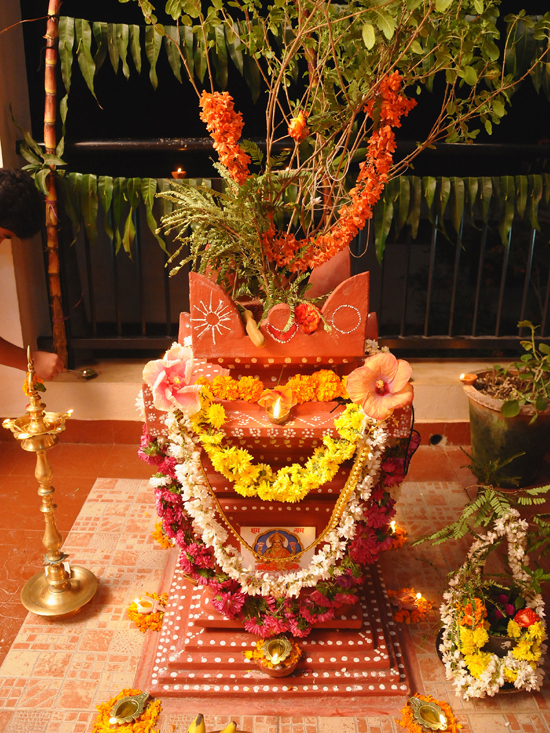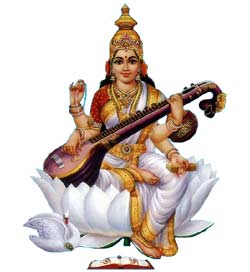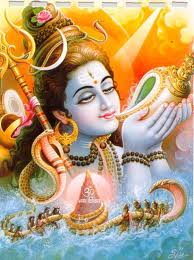- Details
- Written by Administrator
- Category: Festivals
- Hits: 2220

Sri Tulasi Pranama
priyayai keshavasya cha
krishna-bhakti-prade devi
satyavatyai namo namaha
vrndayai--unto Vrnda; tulasi-devyai--unto Tulasl Devi; priyayai-- who is dear; kesavasya--to Lord Kesava; ca-and; krsna-bhakti-- devotional service to Lord Krsna, prade--who bestows; devi--O goddess; satya-vatyai--unto Satyavati; namah namah--repeated obeisances.
TRANSLATION
- Details
- Written by Administrator
- Category: Festivals
- Hits: 4542
Vasant Panchami is an important Indian festival celebrated every year in the month of Magh according to the Hindu calendar. Celebrated on the fifth day of Magh, the day falls somewhere in the months of February or March according to the Gregorian calendar. The significance of the day lies in the worship of Goddess Saraswati, symbol of wisdom and also the onset of spring season.

According to the popular belief, the origins of this festival lie in Aryan period. Aryans came and settled in India through Khyber Pass, crossing the Saraswati River among many others. Being a primitive civilization, most of their development took place along the banks of the River Saraswati. Thus, River Saraswati began to be associated with fertility and knowledge. It is then that the day began to be celebrated.
According to mythology, a popular associated with this day is connected with poet Kalidasa. After he was married off to a beautiful princess through trickery, the princess kicked him out of her bed as she learned that he was foolish. Following this, Kalidasa went to commit suicide, upon which Saraswati emerged from the waters and asked him to take a dip there. After taking a dip in the holy waters, Kalidasa became knowledgeable and began writing poetry. Thus, Vasant Panchami is celebrated to venerate Goddess Saraswati, the goddess of education and learning.
{videoflow}37{/videoflow}
In today’s times, the festival is celebrated by farmers as the on-coming of the spring season. The day is largely celebrated in Northern Parts of India. Here, people offer food to the Brahmins and organize rituals in the name of Goddess Saraswati.
The color yellow is the predominant color associated with the festival, the origins of which are supposed to be the fields of mustard which can be seen in Punjab and Haryana during this period. Kite flying is also commonly associated with this festival. Children as well as adults fly kites on this day to celebrate freedom and enjoyment.
Another tradition associated with this day is that of initiating studies in the young. Young children often begin learning on this day, which is believed to be the reason why the school sessions start in the month of March. Sweets with a yellow hue are also distributed on this day and people can also be seen donating books and other literary material to the poor.
- Details
- Written by Administrator
- Category: Festivals
- Hits: 1596
Legends
According to a legend, Parvati performed tapas, prayed and meditated on this day to ward off any evil that might befall her husband on the moonless night. Since then, Mahashivaratri is believed to be an auspicious occasion for women to pray for the well-being of their husbands and sons. An unmarried woman prays for a husband like Shiva, who is considered to be the ideal husband.Another legend of the day is that Shiva and Shakti married each other.
There is one more legend of shivratri associated with Samudra Manthan, a battle between devas and asuras during which a pot of poison came out of the ocean and on the request of gods, Lord Shiva drank the poison. The poison was so potent that it changed the color of His neck to blue. For this reason, Lord Shiva is also called Neelkanth.
Maha Shivratri Legends
There are numerous interesting legends associated with Maha Shivaratri festival.
Rudra Tandav
According to Rudra Tandava, it was on the Shivaratri night Lord Shiva performed the ‘Tandava Nrithya’ – the cosmic dance of primeval creation, preservation and destruction.
Divine Wedding
Another popular legend is that, Shivrathri marks the divine wedding day of Parvathi Devi and Lord Shiva.
Linga Purana
According to Linga Purana, Lord Shiva manifested himself as the 12 Jyotirlingas (lingams of light) on Shivaratri Day.
Samudra Madhan
Maha Shivaratri is also associated with Samudra Manthan (the Churning of the Ocean), and this is one of the most popular legends associated with Sivaratri. Devas (Gods) and Asuras (Demons) churned the Ocean of Milk to get Amrit or Amrita (the nectar of immortality). While performing the Samudra Manthanam, a pot of highly toxic poison (Kalakuta or Halahal) came out of the ocean. Devas and Asuras were terrified seeing the poison as it was so toxic to destroy all creation. Lord Vishnu advised the Devas and Asuras to pray and seek help of Lord Shiva. Out of compassion for living beings, and leased with the prayers of devas and asuras, Lord Shiva drank the poison. Goddess Parvati was terrified seeing this and stopped the poison in Lord Shiva’s throat with her hands. The poison was so toxic that Shiva’s throat turned blue. Thus the name Neelakantha, which literally means “One who has Blue Throat”. Devas and Asuras started praying the whole night and Lord Shiva was pleased with their devotion and said whoever worships me on Shivaratri day will get all their wishes fulfilled.
Pralaya
Another version relates that the whole world was facing destruction and Goddess Parvati worshipped her husband Shiva to save it. She prayed for the jivas (living souls) remaining in se – like particles of gold dust in a lump of wax - during the long period of pralaya (deluge) night, that they should, upon becoming active again, have His blessings, but only if they worshipped Him just as she did. Her prayer was granted. Parvati named the night for the worship of Ishwara by mortals Maha-Sivaratri, or the great night of Shiva, since Pralaya is brought about by Him.
The Lord Shiva's Favorite Day
After creation was complete, Parvati asked Lord Shiva which devotees and rituals pleased him the most. The Lord replied that the 13th night of the new moon, during the month of Maagha, is his most favourite day. Parvati repeated these words to her friends, from whom the word spread over all creation.
- Details
- Written by Administrator
- Category: Festivals
- Hits: 2477
Lord Brahma started creation on this day - Chaitra suddha padhyami or the Ugadi day. Also the great Indian Mathematician Bhaskaracharya's calculations proclaimed the Ugadi day from the sunrise on as the beginning of the New Year, new month and new day.The onset of spring also marks a beginning of new life with plants (barren until now) acquiring new life, shoots and leaves.Spring is considered the first season of the year hence also heralding a new year and a new beginning.The vibrancy of life and verdant fields, meadows full of colorful blossoms signifies growth, prosperity and well-being.
Predictions of the Year :
Ugadi marks the beginning of a new Hindu lunar calendar with a change in the moon's orbit. It is a day when mantras are chanted and predictions made for the new year. Traditionally, the panchangasravanam or listening to the yearly calendar was done at the temples or at the Town square but with the onset of modern technology, one can get to hear the priest-scholar on television sets right in one's living room.
It is a season for raw mangoes spreading its aroma in the air and the fully blossomed neem tree that makes the air healthy. Also, jaggery made with fresh crop of sugarcane adds a renewed flavor to the typical dishes associated with Ugadi. "Ugadi pachchadi" is one such dish that has become synonymous with Ugadi. It is made of new jaggery, raw mango pieces and neem flowers and new tanarind which truly reflect life - a combination of sweet, sour and bitter tastes!
Preparing for the Occasion :
Decorate the entrance of their houses with fresh mango leaves. The significance of tying mango leaves relates to a legend. It is said that Kartik (or Subramanya or Kumara Swamy) and Ganesha, the two sons of Lord Siva and Parvathi were very fond of mangoes. As the legend goes Kartik exhorted people to tie green mango leaves to the doorway signifying a good crop and general well-being.
It is noteworthy that we use mango leaves and coconuts (as in a Kalasam, to initiate any pooja) only on auspicious occasions to propitiate gods. People also splash fresh cow dung water on the ground in front of their house and draw colorful floral designs. This is a common sight in every household. People perform the ritualistic worship to God invoking his blessings before they start off with the new year. They pray for their health, wealth and prosperity and success in business too. Ugadi is also the most auspicious time to start new ventures.
Season For Pickles :
Mangoes and summer season go hand in hand. Ugadi thus marks the beginning of the hot season which coincides with the school vacations. For the young ones, therefore, Ugadi is characterised by new clothes, sumptuous food and revelling. The air is filled with joy, enthusiasm and gaiety. Some people participate in social community gatherings and enjoy a tranquil evening with devotional songs (bhajans).
- Details
- Written by Administrator
- Category: Festivals
- Hits: 2561
"Raama Raama Raameti Rame Raame Manorame.
Sahasranaama Tattulyam Raamanaama Varaanane."
Rama Navami The festival of Ram Navami is the celebration of birthday of the Hindu God, Shri Ram. Shri Ram was the seventh incarnation (Avatar) of Lord Vishnu and born in Ayodha, an ancient Indian city. Rama Navami is celebrated on the ninth day of Hindu month of Chaitra (April). Ram Navami marks the end of nine day long festival called Chaitra Navratri or Vasanta Navratri. On this auspicious day devotees observes fasting, visits temples to offer special prayers, takes religious processions and the special readings of Ramayana are also hold.
Lord Rama is revered by Hindus all over as the embodiment of truth, of morality, the ideal son, the ideal husband and above all, the ideal king. On the day of Rama Navami the birth of Rama is remembered for his prosperous and righteous reign.
His Divine Life
Rama, the perfect avatar of the Supreme Protector Vishnu, is an all-time favorite among Hindu deities. The most popular symbol of chivalry and virtue, Rama the embodiment of truth, of morality, the ideal son, the ideal husband and above all, the ideal king. The heroic deeds of Rama and his exciting adventures have inspired generations of people.
Importance Of Fasting On Ram Navami
A Ram devotee keep a strict fast on Ram Navami, because the Ram Navami vrata is considered to be one of the five most important vratas in the ancient times. According to the ancient religious texts, it is imperative for every devotee to observe the Ram Navami vrat, as it is the only easy mean of gaining happiness in the material world and achieving salvation at the same time.
Sri Rama Navami is celebrated with a great passion by Hindus. It is believed that Sri Ram Chandra was born on this auspicious day. Chaitra Navaratri is a festival of nine days and the ninth day is termed as Navami. The date falls on of the Hindu month Chaitra and 9th day after new moon. This phase of fortnight is known as Shuklapaksha. As per English calendar the date falls any time in between March and April. The ninth day of the Chaitra Navaratri or Sri Ram Navami is the last day of this festival.
The 7th incarnation of Lord Vishnu was Sri Ram Chandra. He was the great ruler of the kingdom of Ayodhya. The purpose of his birth was to kill the demon King Ravana. Lord Rama is a symbol of embodiment of truth and ethics that’s why this divine person is worshipped by Hindus. He represented himself as a perfect son, the idyllic husband, the idyllic brother and the king with great principles. Lord Rama is respected and memorized for his affluent and honorable sovereignty as a king. The ruling period of Lord Rama called the Ramarajyam which was the era of great harmony, serenity and prosperity. During this ceremony the people belong to northern India generally greet each other as Jai Sri Ram or ‘Jai Ramjee Ki’.
The tale of Lord Rama’s life is known as The Ramayana or The Ramcharitmanas. Maharshi Valmiki had written this divine book and then same was done by Tulsidas correspondingly. After that it has been decoded into almost every Indian lingo and language of India. One will found this book in the home of every Hindu.
Ram Navami begun with early Morning Prayer which was dedicated to the Sun God. This was pursued by the customary worship of Sri Rama which begun with the reciting of Vedic mantras devoted to Lord Vishnu. The God was presented with flowers and fruits. During middle of the day a special prayer was done, dedicated to God Rama, the time when it was done is supposed to be birth time of Lord Rama. After that a procession was taken out where idol of Sri Rama, with wife Sita, brother Lakshmana and devoted disciple Lord Hanuman was arranged in Chariot. People were crowded with great enthusiasm to see this procession.
All enthusiastic Hindu keep starve on this holy day, perform puja, and contribute in the celebrations. Traditional devotees fast through out the Chaitra Navaratri, and live on consuming fruits and milk only. Sri Ram Navami vratam is measured to be one of the five most significant vratams. In a number of old holy books it was referred that performance of the vratam is vital for every devotee. There was a common belief that Lord Rama executes the needs of all his devotees who perform prayer true heartedly devoted to him on this occasion.
On this auspicious day, the verses from the holy book of Ramayana were chanted in almost all temples. The Kalyanotsavam also performed throughout Sri Rama Navami at the Bhadrachalam temple located in AP is very admired by the disciples. A big fair is organized at Ayodhya, the place of birth of Sri Rama. At several places satsangs are held and people are crowded with great passion to celebrate the birth anniversary of the Lord.
Celebrations
It is said that Rama fulfills the wishes of all those who pray to him on this day. On this day, temples are decorated and the image of Lord Ram is richly adorned. The holy Ramayana is read in the temples. At Ayodhya, the birthplace of Sri Rama, a big fair is held on this day. In South India the Sri Ramnavami Utsavam is celebrated for nine days with great fervour and devotion. Traditional worship begins with chanting Vedic mantras dedicated to Vishnu, and offering flowers and fruit to the god. Satsangs and public gatherings are organized to commemorate the birth of Lord Ram. Excerpts from the "Ramacharitamanas", praising Lord Ram, are recited. Lord Ram's devotees, fast for nine days with fruit and milk, whilst some fast on the ninth day only. (referred by-http://www.surfindia.com/ and By-www-Templesindia.org)
Page 1 of 2

